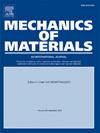基于聚合物固化过程链统计力学的粘弹性分子本构模型
IF 3.4
3区 材料科学
Q2 MATERIALS SCIENCE, MULTIDISCIPLINARY
引用次数: 0
摘要
聚合物在固化过程中表现出复杂的力学行为,从粘性液体到弹性固体,这些都与高柔性聚合物链的动态过程有关。然而,这些物理认识并没有完全融入粘弹性连续介质模型的发展中。基于链统计力学,建立了一种分子本构模型,提供了软聚合物固化过程中粘弹性的分子图谱。假设聚合物网络由纠缠链和交联链组成。首先,基于聚合物动力学推导了单纠缠链的应力演化过程。通过统计描述固化过程中网络结构的演变,分析了固化反应对动态过程的影响。最后,基于仿射变形假设,导出了整个网络的应力本构方程。所提出的模型证明了粘弹性测量的潜在分子意义,如温度位移因子、固化位移因子和弛豫谱。此外,还讨论了粘弹性测量与分子动力学之间的联系以及本构形式的物理基础。本文章由计算机程序翻译,如有差异,请以英文原文为准。

A molecular-derived constitutive model of viscoelasticity based on chain statistical mechanics of polymers during cure
Polymers exhibit complex mechanical behaviors during curing process, ranging from viscous liquids to elastic solids, which are linked to the dynamic processes of the highly flexible polymer chains. However, these physical insights have not been fully integrated into the development of continuum model of viscoelasticity. Based on chain statistical mechanics, a molecular-derived constitutive model is developed to provide molecular picture that underlies the viscoelasticity of soft polymers during cure. The polymer network is assumed to comprise the entangled chain and crosslinked strands. At first, the stress evolution of a single entangled chain is derived from its dynamic process based on polymer dynamics. Then the effect of curing reaction on the dynamic process is analyzed by statistically describing the evolution of the network structure during cure. Finally, the stress constitutive equation of the whole network is derived based on the affine deformation assumption. The underlying molecular meanings of viscoelastic measurements such as the temperature shift factor, the cure shift factor and the relaxation spectrum, are demonstrated by the proposed model. Further, the connection between viscoelastic measurements and molecular dynamics as well as the physical foundation of the constitutive form is discussed.
求助全文
通过发布文献求助,成功后即可免费获取论文全文。
去求助
来源期刊

Mechanics of Materials
工程技术-材料科学:综合
CiteScore
7.60
自引率
5.10%
发文量
243
审稿时长
46 days
期刊介绍:
Mechanics of Materials is a forum for original scientific research on the flow, fracture, and general constitutive behavior of geophysical, geotechnical and technological materials, with balanced coverage of advanced technological and natural materials, with balanced coverage of theoretical, experimental, and field investigations. Of special concern are macroscopic predictions based on microscopic models, identification of microscopic structures from limited overall macroscopic data, experimental and field results that lead to fundamental understanding of the behavior of materials, and coordinated experimental and analytical investigations that culminate in theories with predictive quality.
 求助内容:
求助内容: 应助结果提醒方式:
应助结果提醒方式:


